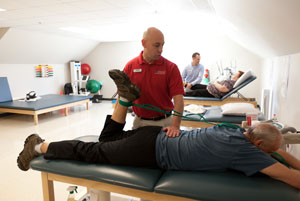
Causes of hip pain | Understanding symptoms | Nonsurgical treatments | Surgical options | Hip prevention
The primary cause of hip pain is arthritis, specifically osteoarthritis. Arthritis is the most common chronic condition and is characterized by inflammation of the joints. Common causes of arthritis include wear and tear on the bones and joint cartilage, most often when the body has too much weight to support. This can be caused by carrying heavy loads consistently for years but is more commonly a byproduct of being overweight.

Osteoarthritis is the most common form of arthritis, affecting over 21 million Americans. Three times as many women suffer from the disease than men.
Osteoarthritis occurs when the covering on the ends of bones gradually wears away, becoming frayed and rough. It typically develops due to many years of use and affects people middle-aged and older. Osteoarthritis targets hands and weight-bearing joints, such as knees, hips, feet and back.
Our hips form and develop in mass and strength in proportion to the amount of weight our body was designed to hold. So if you are a small woman, your hips are meant to hold a smaller amount of weight than if you are a six-foot tall man. Although the body is very adaptable and can learn to hold different weights, a point can be reached where the body is simply not comfortable supporting excess weight.
In some cases, along with surgery, a lifestyle change needs to take place to keep chronic pain at bay. For instance, diet should be addressed immediately, and an exercise regime should ensue following recovery from surgery.

Avascular necrosis occurs when the tissue in the joints literally die when the blood supply is cut off to the bones. This can be a temporary blood supply loss or a permanent loss. Causes of avascular necrosis can include alcoholism, steroids, or blood disorders.
In the early stages of avascular necrosis, pain only occurs when pressure is put on the joint. However, as the necrosis worsens the pain is present even while resting the joint. In many cases, the blood supply is lost permanently and the damage tissue must be removed and replaced with a hip replacement.
The hip labrum is a unique ring structure made of soft elastic tissue that covers the acetabulum (socket) of the hip. The labrum helps the hip move smoothly without problems or pain. The shape and function of the labrum is similar to a bumper cushion. The labrum functions as a seal by keeping the ball and socket together but not touching. The labrum contains nerve fibers that make tears within the labrum very painful.
A hip labral tear is an injury to the labrum. Labral tears typically occur from repetitive motion, osteoarthritis, or trauma. A hip labral tear can be caused by injury, structural abnormalities, or degenerative issues. Athletes have a higher risk of developing a hip labral tear. Symptoms include pain in the hip, stiffness in the joint, or a limited range of motion.
A hip labral tear can be treated nonsurgically, or patients with severe labral tearing may require surgery. Treatments can include rest and activity modification, medication, physical therapy, or surgery. Hip arthroscopy is a superb solution for relieving hip pain. The surgery repairs the damaged hip by separating the ball and socket within the hip joint. The procedure is an outpatient procedure that only requires small leg incisions and promotes accelerated rehabilitation.
Mechanical abnormalities are rare, but can stem from childhood disfigurement or fractures that never healed properly. Initially, the body will try to compensate for the abnormality. However, as time passes, this will create wear and tear on other parts of the body. Ultimately, the remedy for this can be hip replacement.
Those with fragile bones that may easily break have osteoporosis. The disease is the result of lower than average amounts of phosphate and calcium in the bones, which cases them to become porous and brittle. Bones that most commonly break are the bones in the spine, wrist and hip.
There are both controllable and uncontrollable risk factors that increase or decrease odds of developing the disease. For instance, people of all ages, races and genders get osteoporosis, but it is a condition most commonly found in Caucasian and Asian females over the age of 60. Other uncontrollable risk factors include: family history, certain diseases and hormone levels. Controllable factors encompass those things that an individual can do during their lifetimes to lower their risk for developing osteoporosis. For instance, smoking, excessive drinking (more than 7 ounces of alcohol per week), poor nutrition with low calcium intake and lack of exercise can all contribute to the development of the disease.
The best treatment for the disease is prevention by consuming the recommended amounts of calcium and phosphate throughout a lifetime. When the disease is recognized, calcium is prescribed into the diet immediately, hormone treatments may help and an exercise regimen is recommended to abate further deterioration of the bone. To find out if you have osteoporosis, an energy X-ray absorptiometry (DEXA) scanning can analyze bone density.
Hip pain can be caused by osteoarthritis, fractures, dislocations, rheumatoid arthritis, aseptic bone necrosis, and avascular necrosis. Treatment options can vary from rehabilitation to total hip replacement surgery. A total hip surgery consists of removing the damaged area and replacing that area with a prosthesis that acts like a joint. The prosthesis allows for smooth and frictionless motion.
A candidate of total hip surgery is someone that has intense pain and difficulty performing everyday activities such as walking or standing. Doctors will usually exhaust all non-invasive procedures before electing surgery for the patient. Total hip replacement has become a common procedure among the aging population. Most patients will enjoy relief from pain and improved function following the surgery and rehabilitation. In the United States, the average joint replacement patient is around 60-70 years old. However, all different ages have received hip implants due to certain health and trauma issues. The life of the prosthesis depends on factors like a patient’s physical condition and activity level, body weight and the surgical technique.